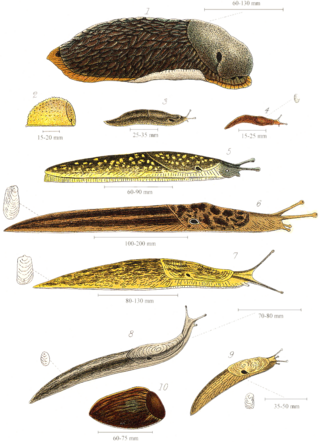
In botanical nomenclature, variety is a taxonomic rank below that of species and subspecies, but above that of form. As such, it gets a three-part infraspecific name. It is sometimes recommended that the subspecies rank should be used to recognize geographic distinctiveness, whereas the variety rank is appropriate if the taxon is seen throughout the geographic range of the species.

Poecilia is a genus of fishes in the family Poeciliidae of the order Cyprinodontiformes. These livebearers are native to fresh, brackish and salt water in the Americas, and some species in the genus are euryhaline. A few have adapted to living in waters that contain high levels of toxic hydrogen sulfide and a population of P. mexicana lives in caves.

The viviparous lizard, or common lizard, is a Eurasian lizard. It lives farther north than any other species of non-marine reptile, and is named for the fact that it is viviparous, meaning it gives birth to live young. Both "Zootoca" and "vivipara" mean "live birth", in (Latinized) Greek and Latin respectively. It was called Lacerta vivipara until the genus Lacerta was split into nine genera in 2007 by Arnold, Arribas & Carranza.

The Trichocephalida is an order of parasitic nematodes.

Bistorta vivipara is a perennial herbaceous flowering plant in the knotweed and buckwheat family Polygonaceae, commonly known as alpine bistort. Scientific synonyms include Bistorta vivipara and Polygonum viviparum. It is common all over the high Arctic through Europe, North America, incl. Greenland, and temperate and tropical Asia. Its range stretches further south in high mountainous areas such as the Alps, Carpathians, Pyrenees, Caucasus, Alaska and the Tibetan Plateau.

Kerr's Pink is a potato cultivar in wide production in Ireland and the United Kingdom and many other countries. Although often quoted as an "Irish potato", the cultivar was actually created by J. Henry of Cornhill, Scotland, in 1907.

Pratylenchus penetrans is a species of nematode in the genus Pratylenchus, the lesion nematodes. It occurs in temperate regions worldwide, regions between the subtropics and the polar circles. It is an animal that inhabits the roots of a wide variety of plants and results in necrotic lesions on the roots. Symptoms of P. penetrans make it hard to distinguish from other plant pathogens; only an assay of soil can conclusively diagnose a nematode problem in the field. P. penetrans is physically very similar to other nematode species, but is characterized by its highly distinctive mouthpiece. P. penetrans uses its highly modified mouth organs to rupture the outer surface of subterranean plant root structures. It will then enter into the root interior and feed on the plant tissue inside. P. penetrans is considered to be a crop parasite and farmers will often treat their soil with various pesticides in an attempt to eliminate the damage caused by an infestation. In doing this, farmers will also eliminate many of the beneficial soil fauna, which will lead to an overall degradation of soil quality in the future. Alternative, more environmentally sustainable methods to control P. penetrans populations may be possible in certain regions.

Anguina agrostis is a plant pathogenic nematode.

Pelecyphora vivipara is a species of cactus known by several common names, including spinystar, viviparous foxtail cactus, pincushion cactus and ball cactus. It is native to North America, where certain varieties can be found from Mexico to Canada. Most of these varieties are limited to the Mojave and Sonoran Deserts. The species epithet "vivipara" is due to the species' viviparous reproductive habit.

Slug, or land slug, is a common name for any apparently shell-less terrestrial gastropod mollusc. The word slug is also often used as part of the common name of any gastropod mollusc that has no shell, a very reduced shell, or only a small internal shell, particularly sea slugs and semi-slugs.

The nematodes, roundworms or eelworms constitute the phylum Nematoda. They are a diverse animal phylum inhabiting a broad range of environments. Most species are free-living, feeding on microorganisms, but many species are parasitic. The parasitic worms (helminths) are the cause of soil-transmitted helminthiases.

Nematoida is a clade of pseudocoelomate free living or parasitic animals. It consists of phyla Nematoda and Nematomorpha. The two groups share a number of features in common; the presence of a cloaca in both sexes, aflagellate sperm, and a cuticle made of collagen.

Festuca vivipara, the viviparous sheep's-fescue, is a species of grass native to northern Europe, northern Asia, and subarctic North America. The specific epithet vivipara is Latin, referring to the florets' alteration to leafy tufts. The plant can have a diploid number of 28, 49, 56, or 63, though numbers of 21, 35, and 42 have also been reported.
Parvulastra vivipara, the Tasmanian live-bearing seastar, is a tiny, uniformly orange-yellow seastar, up to 15 mm (0.6 in) across. The species usually has five short arms and is a rounded, pentagon shape. Morphological variation is common and three, four or six arms are occasionally present. It is endemic to coastal waters in southeast Tasmania.

Remusatia vivipara also called hitchhiker elephant ear is a perennial herb growing up to 50 cm tall in the genus Remusatia. It is widespread throughout the world, growing in temperate climates.
Plectus parvus is a species of nematode (roundworm) found in freshwater and terrestrial environments. It has been sampled in Europe and New Zealand. Along with the similar nematode Panagrolaimus detritophagus, in 2018 it was the first species of multicellular eukaryote to be thawed into a living state after prolonged cryopreservation. Female worms of this species were found in Pleistocene permafrost in the Kolyma River lowland. They were mobile and ate, after being frozen for 30–40 thousand years.
Xyalidae is a family of nematodes belonging to the order Monhysterida.
Atractidae is a family of nematodes belonging to the order Rhabditida.
Micropleura is a genus of nematodes belonging to the family Micropleuridae.
Longibucca is a genus of nematodes belonging to the family Diplogastridae.













